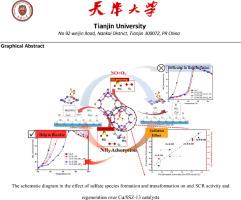Journal of the Taiwan Institute of Chemical Engineers ( IF 5.7 ) Pub Date : 2021-01-13 , DOI: 10.1016/j.jtice.2020.12.033 Chen Wang , Zexiang Chen , Jun Wang , Jianqiang Wang , Meiqing Shen

|
In order to investigate sulfate poisoning of Cu/SSZ-13 catalysts used for NOx removal by selective catalytic reduction with ammonia (NH3-SCR), they were exposed to SO2 at different temperatures in the presence and absence of NH3. Standard physicochemical characterization and density functional theory calculations were performed to probe the nature of the sulfate species formed on the catalyst and the corresponding effects. The results showed that sulfate poisoning has little effect on the chabazite structure of the catalyst, but the sulfate species formed blocks the Cu/SSZ-13 pores. For sulfation with pure SO2, copper bisulfate forms and its content increases with sulfation temperature. However, in the presence of NH3, the major sulfate formed is ammonium bisulfate (~80%). Moreover, the total sulfate contents are lower for higher sulfation temperatures because of difficulties in ammonium bisulfate formation. Regardless of the kind of sulfate species formed, the poisoning leads to lower availability of active sites, causing inferior NOx conversion. Importantly, as copper bisulfate and ammonium bisulfate on Z-Cu(OH)+ are interconvertible, our study reveals that using NH3 to promote the transformation from copper bisulfate to ammonium bisulfate is a viable method to improve the recovery effect of sulfated Cu/SSZ-13.
中文翻译:

揭示了作为选择性还原催化剂的Cu / SSZ-13上硫中毒的性质
为了研究用于NO铜/ SSZ-13的催化剂的硫酸盐中毒X通过与氨(NH选择性催化还原去除3 -SCR),将它们暴露于SO 2在NH的存在和不存在不同的温度3。进行了标准的理化表征和密度泛函理论计算,以探究催化剂上形成的硫酸盐物种的性质以及相应的作用。结果表明,硫酸盐中毒对催化剂菱沸石的结构影响不大,但形成的硫酸盐却阻塞了Cu / SSZ-13孔。用于纯SO 2的硫酸盐化,硫酸氢铜的形式,其含量随硫酸化温度增加。然而,在NH 3存在下,形成的主要硫酸盐是硫酸氢铵(〜80%)。此外,由于难以形成硫酸氢铵,因此对于较高的硫酸化温度,总硫酸盐含量较低。无论形成哪种硫酸盐,中毒都会导致活性位点的利用率降低,从而导致NOx转化率降低。重要的是,由于Z-Cu(OH)+上的硫酸氢铜和硫酸氢铵是可相互转化的,因此我们的研究表明,使用NH 3促进硫酸氢铜向硫酸氢铵的转化是提高硫酸化Cu / SSZ回收率的可行方法。 -13。


























 京公网安备 11010802027423号
京公网安备 11010802027423号